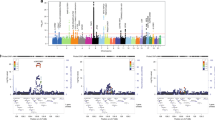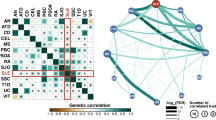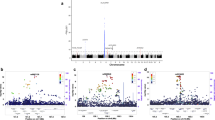Abstract
In our earlier study, we utilized a Bayesian design to probe the association of ∼1000 genes (∼10 000 single-nucleotide polymorphisms (SNPs)) with systemic lupus erythematosus (SLE) on a moderate number of trios of parents and children with SLE. Two genes associated with SLE, with a multitest-corrected false discovery rate (FDR) of <0.05, were identified, and a number of noteworthy genes with FDR of <0.8 were also found, pointing out a future direction for the study. In this report, using a large population of controls and adult- or childhood-onset SLE cases, we have extended the earlier investigation to explore the SLE association of 10 of these noteworthy genes (109 SNPs). We have found that seven of these genes exhibit a significant (FDR<0.05) association with SLE, both confirming some genes that have earlier been found to be associated with SLE (PTPN22 and IRF5) and presenting novel findings of genes (KLRG1, interleukin-16, protein tyrosine phosphatase receptor type T, toll-like receptor (TLR)8 and CASP10), which have not been reported earlier. The results signify that the two-step candidate pathway design is an efficient way to study the genetic foundations of complex diseases. Furthermore, the novel genes identified in this study point to new directions in both the diagnosis and the eventual treatment of this debilitating disease.
This is a preview of subscription content, access via your institution
Access options
Subscribe to this journal
Receive 6 digital issues and online access to articles
$119.00 per year
only $19.83 per issue
Buy this article
- Purchase on Springer Link
- Instant access to full article PDF
Prices may be subject to local taxes which are calculated during checkout



Similar content being viewed by others
References
Collins FS, Guyer MS, Charkravarti A . Variations on a theme: cataloging human DNA sequence variation. Science 1997; 278: 1580–1581.
Pearson TA, Manolio TA . How to interpret a genome-wide association study. JAMA 2008; 299: 1335–1344.
Cohen JC, Kiss RS, Pertsemlidis A, Marcel YL, McPherson R, Hobbs HH . Multiple rare alleles contribute to low plasma levels of HDL cholesterol. Science 2004; 305: 869–872.
Romeo S, Pennacchio LA, Fu Y, Boerwinkle E, Tybjaerg-Hansen A, Hobbs HH et al. Population-based resequencing of ANGPTL4 uncovers variations that reduce triglycerides and increase HDL. Nat Genet 2007; 39: 513–516.
Iles MM . What can genome-wide association studies tell us about the genetics of common disease? PLoS Genet 2008; 4: e33.
Hunter DJ, Kraft P . Drinking from the fire hose—statistical issues in genomewide association studies. N Engl J Med 2007; 357: 436–439.
Wang WY, Barratt BJ, Clayton DG, Todd JA . Genome-wide association studies: theoretical and practical concerns. Nat Rev Genet 2005; 6: 109–118.
Jorgenson E, Witte JS . Coverage and power in genomewide association studies. Am J Hum Genet 2006; 78: 884–888.
Cambien F, Tiret L . Genetics of cardiovascular diseases: from single mutations to the whole genome. Circulation 2007; 116: 1714–1724.
Armstrong DL, Jacob CO, Zidovetzki R . Function2Gene: a gene selection tool to increase the power of genetic association studies by utilizing public databases and expert knowledge. BMC Bioinformatics 2008; 9: 311–317.
Jacob CO, Reiff A, Armstrong DL, Myones BL, Silverman E, Klein-Gitelman M et al. Identification of novel susceptibility genes in childhood-onset Systemic Lupus Erythematosus using a uniquely designed candidate gene pathway platform. Arthritis Rheum 2007; 56: 4164–4173.
Cassidy JT . Systemic Lupus Erythemaetosus. In: Cassidy JT, Petty RE (eds). Textbook of Pediatric Rheumatology. Elsevier Saunders: Philadelphia, 1996, pp 329–406.
Lehman TJA . Systemic Lupus Erythemaetosus in childhood and adolescence. In: Wallace DJ, Hahn BH (eds). Dubois’ Lupus Erythematosus. Lippincott Williams & Wilkins: Philadelphia, 2002, pp 863–884.
Price AL, Patterson NJ, Plenge RM, Weinblatt ME, Shadick NA, Reich D . Principal components analysis corrects for stratification in genome-wide association studies. Nat Genet 2006; 38: 904–909.
Cordell HJ, Clayton DG . Genetic association studies. Lancet 2005; 366: 1121–1131.
Benjamini Y, Hochberg Y . Controlling the false discovery rate: a practical and powerful approach to multiple testing. J Stat Soc 1995; 85: 289–300.
Graham RR, Kozyrev SV, Baechler EC, Reddy MV, Plenge RM, Bauer JW et al. A common haplotype of interferon regulatory factor 5 (IRF5) regulates splicing and expression and is associated with increased risk of systemic lupus erythematosus. Nat Genet 2006; 38: 550–555.
Kelly JA, Kelley JM, Kaufman KM, Kilpatrick J, Bruner GR, Merrill JT et al. Interferon regulatory factor-5 is genetically associated with systemic lupus erythematosus in African Americans. Genes Immun 2008; 9: 187–194.
Sigurdsson S, Göring HH, Kristjansdottir G, Milani L, Nordmark G, Sandling JK et al. Comprehensive evaluation of the genetic variants of interferon regulatory factor 5 (IRF5) reveals a novel 5 bp length polymorphism as strong risk factor for systemic lupus erythematosus. Hum Mol Genet 2008; 17: 872–881.
Graham RR, Kyogoku C, Sigurdsson S, Vlasova IA, Davies LR, Baechler EC et al. Three functional variants of IFN regulatory factor 5 (IRF5) define risk and protective haplotypes for human lupus. Proc Natl Acad Sci USA 2007; 104: 6758–6763.
Siu HO, Yang W, Lau CS, Chan TM, Wong RW, Wong WH et al. Association of a haplotype of IRF5 gene with systemic lupus erythematosus in Chinese. J Rheumatol 2008; 35: 360–362.
Maraganore DM, de Andrade M, Lesnick TG, Strain KJ, Farrer MJ, Rocca WA et al. High-resolution whole-genome association study of Parkinson disease. Am J Hum Genet 2005; 77: 685–693.
Wellcome Trust Case Control Consortium. Genome-wide association study of 14,000 cases of seven common diseases and 3,000 shared controls. Nature 2007; 447: 661–678.
Baum AE, Akula N, Cabanero M, Cardona I, Corona W, Klemens B et al. A genome-wide association study implicates diacylglycerol kinase eta (DGKH) and several other genes in the etiology of bipolar disorder. Mol Psychiatry 2008; 13: 197–207.
Harley JB, Alarcón-Riquelme ME, Criswell LA, Jacob CO, Kimberly RP, Moser KL et al. Genome-wide association scan in women with systemic lupus erythematosus identifies susceptibility variants in ITGAM, PXK, KIAA1542 and other loci. Nat Genet 2008; 40: 204–210.
Hom G, Graham RR, Modrek B, Taylor KE, Ortmann W, Garnier S et al. Association of systemic lupus erythematosus with C8orf13-BLK and ITGAM-ITGAX. N Engl J Med 2008; 358: 900–909.
Kozyrev SV, Abelson AK, Wojcik J, Zaghlool A, Linga Reddy MV, Sanchez E et al. Functional variants in the B-cell gene BANK1 are associated with systemic lupus erythematosus. Nat Genet 2008; 40: 211–216.
Graham RR, Cotsapas C, Davies L, Hackett R, Lessard CJ, Leon JM et al. Genetic variants near TNFAIP3 on 6q23 are associated with systemic lupus erythematosus. Nat Genet 2008; 40: 1059–1061.
Altshuler D, Daly M . Guilt beyond a reasonable doubt. Nat Genet 2007; 39: 813–814.
Voehringer D, Koschella M, Pircher H . Lack of proliferative capacity of human effector and memory T cells expressing killer cell lectinlike receptor G1 (KLRG1). Blood 2002; 100: 3698–3702.
Erkeller-Yusel F, Hulstaart F, Hannet I, Isenberg D, Lydyard P . Lymphocyte subsets in a large cohort of patients with systemic lupus erythematosus. Lupus 1999; 2: 227–231.
Yabuhara A, Yang FC, Nakazawa T, Iwasaki Y, Mori T, Koike K et al. A killing defect of natural killer cells as an underlying immunologic abnormality in childhood systemic lupus erythematosus. J Rheumatol 1996; 23: 171–177.
Green MR, Kennell AS, Larche MJ, Seifert MH, Isenberg DA, Salaman MR . Natural killer cell activity in families of patients with systemic lupus erythematosus: demonstration of a killing defect in patients. Clin Exp Immunol 2005; 141: 165–173.
Stohl W, Elliott JE, Hamilton AS, Deapen DM, Mack TM, Horwitz DA . Impaired recovery and cytolytic function of CD56+ T and non-T cells in systemic lupus erythematosus following in vitro polyclonal T cell stimulation. Studies in unselected patients and monozygotic disease-discordant twins. Arthritis Rheum 1996; 39: 1840–1851.
Beyersdorf N, Ding X, Tietze JK, Hanke T . Characterization of mouse CD4 T cell subsets defined by expression of KLRG1. Eur J Immunol 2007; 37: 3445–3454.
Lee S, Kaneko H, Sekigawa I, Tokano Y, Takasaki Y, Hashimoto H . Circulating interleukin-16 in systemic lupus erythematosus. Br J Rheumatol 1998; 37: 1334–1337.
Lard LR, Roep BO, Verburgh CA, Zwinderman AH, Huizinga TW . Elevated IL-16 levels in patients with systemic lupus erythematosus are associated with disease severity but not with genetic susceptibility to lupus. Lupus 2002; 11: 181–185.
Theodore AC, Center DM, Nicoll J, Fine G, Kornfeld H, Cruikshank WW . CD4 ligand IL-16 inhibits the mixed lymphocyte reaction. J Immunol 1996; 157: 1958–1964.
Klimiuk PA, Goronzy JJ, Weyand CM . IL-16 as an anti-inflammatory cytokine in rheumatoid synovitis. J Immunol 1999; 162: 4293–4299.
McFadden C, Morgan R, Rahangdale S, Green D, Yamasaki H, Center D et al. Preferential migration of T regulatory cells induced by IL-16. J Immunol 2007; 179: 6439–6445.
Vollmer J, Tluk S, Schmitz C, Hamm S, Jurk M, Forsbach A et al. Immune stimulation mediated by autoantigen binding sites within small nuclear RNAs involves Toll-like receptors 7 and 8. J Exp Med 2005; 202: 1575–1585.
Baechler EC, Batliwalla FM, Karypis G, Gaffney PM, Ortmann WA, Espe KJ et al. Interferon-inducible gene expression signature in peripheral blood cells of patients with severe lupus. Proc Natl Acad Sci USA 2003; 100: 2610–2615.
Bennett L, Palucka AK, Arce E, Cantrell V, Borvak J, Banchereau J et al. Interferon and granulopoiesis signatures in systemic lupus erythematosus blood. J Exp Med 2003; 197: 711–723.
Rhodes B, Vyse TJ . The genetics of SLE: an update in the light of genome-wide association studies. Rheumatol 2008; 47: 1603–1611.
Barnes BJ, Kellum MJ, Pinder KE, Frisancho JA, Pitha PM . Interferon regulatory factor 5, a novel mediator of cell cycle arrest and cell death. Cancer Res 2003; 63: 6424–6431.
Mevorach D . Systemic lupus erythematosus and apoptosis: a question of balance. Clin Rev Allergy Immunol 2003; 25: 49–60.
Mehrian R, Quismorio Jr FP, Strassmann G, Stimmler MM, Horwitz DA, Kitridou RC et al. Synergistic effect between IL-10 and bcl-2 genotypes in determining susceptibility to systemic lupus erythematosus. Arthritis Rheum 1998; 41: 596–602.
Wang J, Zheng L, Lobito A, Chan FK, Dale J, Sneller M et al. Inherited human Caspase 10 mutations underlie defective lymphocyte and dendritic cell apoptosis in autoimmune lymphoproliferative syndrome type II. Cell 1999; 98: 47–58.
Müllauer L, Gruber P, Sebinger D, Buch J, Wohlfart S, Chott A . Mutations in apoptosis genes: a pathogenetic factor for human disease. Mutat Res 2001; 488: 211–231.
Staudt LM, Dent AL, Shaffer AL, Yu X . Regulation of lymphocyte cell fate decisions and lymphomagenesis by BCL6. Int Rev Immunol 1999; 18: 381–403.
Dent AL, Shaffer AL, Yu X, Allman D, Staudt LM . Control of inflammation, cytokine expression, and germinal center formation by BCL6. Science 1997; 276: 589–592.
Ye BH, Cattoretti G, Shen Q, Zhang J, Hawe N, de Waard R et al. The BCL6 proto-oncogene controls germinal-centre formation and Th2-type inflammation. Nat Genet 1997; 16: 161–170.
Kyogoku C, Langefeld CD, Ortmann WA, Lee A, Selby S, Carlton VE et al. Genetic association of the R620W polymorphism of protein tyrosine phosphatase PTPN22 with human SLE. Am J Hum Genet 2004; 75: 504–507.
Wu H, Cantor RM, Graham DS, Lingren CM, Farwell L, Jager PL et al. Association analysis of the R620W polymorphism of protein tyrosine phosphatase PTPN22 in systemic lupus erythematosus families: increased T allele frequency in systemic lupus erythematosus patients with autoimmune thyroid disease. Arthritis Rheum 2005; 52: 2396–2402.
Lee YH, Rho YH, Choi SJ, Ji JD, Song GG, Nath SK et al. The PTPN22 C1858T functional polymorphism and autoimmune diseases—a meta-analysis. Rheumatology 2007; 46: 49–56.
Zhang X, Guo A, Yu J, Possemato A, Chen Y, Zheng W et al. Identification of STAT3 as a substrate of receptor protein tyrosine phosphatase T. Proc Natl Acad Sci USA 2007; 104: 4060–4064.
Julià A, Ballina J, Cañete JD, Balsa A, Tornero-Molina J, Naranjo A et al. Genome-wide association study of rheumatoid arthritis in the Spanish population: KLF12 as a risk locus for rheumatoid arthritis susceptibility. Arthritis Rheum 2008; 58: 2275–2286.
Plenge RM, Cotsapas C, Davies L, Price AL, de Bakker PI, Maller J et al. Two independent alleles at 6q23 associated with risk of rheumatoid arthritis. Nat Genet 2007; 39: 1477–1482.
Hochberg MC . Updating the American College of Rheumatology revised criteria for the classification of systemic lupus erythematosus. Arthritis Rheum 1997; 40: 1725.
González JR, Armengol L, Solé X, Guinó E, Mercader JM, Estivill X et al. SNPassoc: an R package to perform whole genome association studies. Bioinformatics 2007; 23: 644–645.
Purcell S, Neale B, Todd-Brown K, Thomas L, Ferreira MA, Bender D et al. PLINK: a toolset for whole-genome association and population-based linkage analysis. Am J Hum Genet 2007; 81: 559–575.
Barrett JC, Fry B, Maller J, Daly MJ . Haploview: analysis and visualization of LD and haplotype maps. Bioinformatics 2005; 21: 263–265.
Storey JD, Tibshirani R . Statistical significance for genomewide studies. Proc Natl Acad Sci USA 1995; 100: 9440–9445.
Acknowledgements
This work was supported in part by NIH Grant RO1AR445650 to COJ and ALR, Grant 52104 to COJ and RZ. Work at OMRF was supported by National Institutes of Health (AI063622, RR020143, AR053483, AR049084, AI24717, AR42460, AR048940, AR445650 and AR043274), the Alliance for Lupus Research and the US Department of Veterans Affairs. The work at UAB was supported by NIH grants P01-AR49084 and P60-AR48095, SCB was supported by the Ministry for Health, Welfare and Family Affairs, Republic of Korea grants A010252 and A080588.
Author information
Authors and Affiliations
Corresponding authors
Additional information
Supplementary Information accompanies the paper on Genes and Immunity website (http://www.nature.com/gene)
Rights and permissions
About this article
Cite this article
Armstrong, D., Reiff, A., Myones, B. et al. Identification of new SLE-associated genes with a two-step Bayesian study design. Genes Immun 10, 446–456 (2009). https://doi.org/10.1038/gene.2009.38
Received:
Accepted:
Published:
Issue Date:
DOI: https://doi.org/10.1038/gene.2009.38
Keywords
This article is cited by
-
Systemic Lupus Erythematosus in Children and Young People
Current Rheumatology Reports (2021)
-
Genetic polymorphisms of C-type lectin receptors in Behcet’s disease in a Chinese Han population
Scientific Reports (2017)
-
GWAS identifies novel SLE susceptibility genes and explains the association of the HLA region
Genes & Immunity (2014)
-
Genome-wide association study identifies novel loci associated with resistance to bovine tuberculosis
Heredity (2014)
-
Single nucleotide polymorphisms in genes encoding toll-like receptors 7, 8 and 9 in Danish patients with systemic lupus erythematosus
Molecular Biology Reports (2014)



